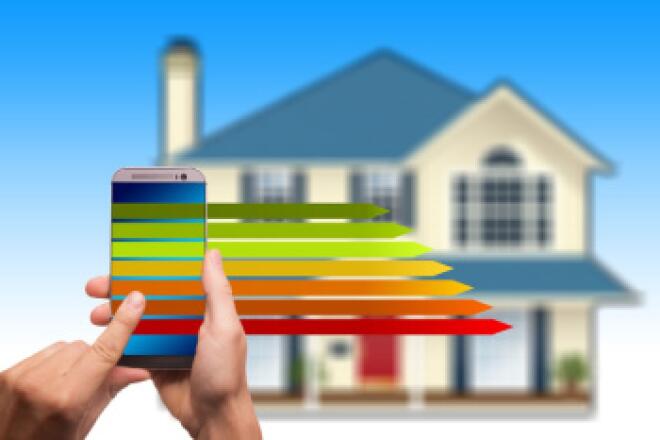
No- and Low-Cost Tips to Save Energy at Home
Saving money on your monthly electric bill doesn’t have to involve a high upfront cost for you. Although smart thermostats and appliances seem to be attracting all the attention, there are many no- and low-cost, do-it-yourself projects that can make a major impact on your home’s energy use and your monthly bill. Use the tips below to take your energy efficiency to a new level.
---
Take advantage of air circulation from ceiling fans.
Circulating the air in a room can make a major difference in comfort while limiting energy use. In the summer, use the switch on your fan to rotate the blades counterclockwise and push cool air down. In the winter, switch to clockwise to push the warmer air near the ceiling down along the walls into the main area of the room. Also, turn the ceiling fan off when you leave a room to save energy; you can only feel the effect when you’re in the room.
Stop the draft with weather-stripping and caulking.
 A drafty home can cause your heating and cooling costs to skyrocket, but fortunately, there’s a lot you can do to improve the situation. Weather-stripping and caulk can be purchased at any home improvement store for a quick, inexpensive weekend project. Use weatherstripping on any movable part of your home (windows, doors, etc.) and caulk for filling cracks and gaps. According to the Department of Energy, air sealing a drafty home can save you 20 percent or more on heating and cooling!
A drafty home can cause your heating and cooling costs to skyrocket, but fortunately, there’s a lot you can do to improve the situation. Weather-stripping and caulk can be purchased at any home improvement store for a quick, inexpensive weekend project. Use weatherstripping on any movable part of your home (windows, doors, etc.) and caulk for filling cracks and gaps. According to the Department of Energy, air sealing a drafty home can save you 20 percent or more on heating and cooling!
Check with your power company for a free Energy Saving Kit.
Power companies have many reasons for supporting their customers' energy efficiency efforts, so if you’re trying to reduce your overall energy use, a good starting place is just checking with your power company. Many utilities offer free Energy Saving Kits to get their customers started down the path of saving energy. These can include free LED light bulbs, advanced power strips and other energy-saving measures. Your utility may also have other free programs or advice for helping you save.
Use curtains, blinds and shades to your advantage.
Did you know that about three-quarters of the sunlight that hits the standard double-pane window enters the home as heat? In colder months, open curtains or blinds on windows that receive a lot of sunlight each day to heat your home. During the warmer months, keep them closed to reduce the amount you spend on cooling.
Make better energy-related buying decisions.
When you need to replace an appliance around your home, like a washing machine, water heater or TV, avoid making an energy-inefficient purchase. By using an online tool to compare products, you can find the most energy-efficient appliance for your needs. Even if it costs a little more upfront, you’ll likely save quite a bit over the appliance’s lifetime. You can also look for the ENERGY STAR® label, a government-backed symbol that lets you know a product is more energy efficient than others you might choose.
Turn off your lights and unplug unused appliances.
The old adage “Turn off the lights when you leave a room” is great advice for being more energy efficient, but did you know that appliances like coffee makers and gaming consoles can also be major sources of wasted energy? Many appliances, like your cable box or TV, still draw some power while turned off or in standby mode. Some sources estimate that these “energy vampires” account for 10 to 20 percent of a home’s total energy use! Consider adding appliances and devices to a power strip to conveniently turn them on and off, and you should start seeing a decrease in your bill.
Ditch your old lightbulbs for energy-saving LEDs.
The standard household lightbulb has come a long way over the past decade. Once a major source of energy use, lighting now only uses about 6 percent of total household electricity. This is mainly due to the growth of LEDs, which use about 80 to 90 percent less energy and last 10 times longer than traditional incandescent bulbs—and they’ve also decreased in price by 85 percent in recent years. But if you’re not keen on spending the money to upgrade, your power company may have a free Energy Saving Kit or instant rebates to cut the cost significantly. Further, some community organizations and food banks also offer packs of LED bulbs to help cut down energy bills.
Take control of your thermostat.
 Even if you don’t have the latest smart thermostat, how you operate your home’s thermostat can still make a major impact on your home’s energy use. According to the Department of Energy, turning back your thermostat 7°F to 10°F for eight hours a day from its normal setting can save you 10 percent or more on heating and cooling. If you have a programmable thermostat, you can create settings for when you wake up, leave for work, get home, etc., and the adjustments will be automatically made. A smart thermostat, which can sometimes be purchased for under $50 with a rebate from your power company, can learn your schedule and preferences and adjust the temperature accordingly.
Even if you don’t have the latest smart thermostat, how you operate your home’s thermostat can still make a major impact on your home’s energy use. According to the Department of Energy, turning back your thermostat 7°F to 10°F for eight hours a day from its normal setting can save you 10 percent or more on heating and cooling. If you have a programmable thermostat, you can create settings for when you wake up, leave for work, get home, etc., and the adjustments will be automatically made. A smart thermostat, which can sometimes be purchased for under $50 with a rebate from your power company, can learn your schedule and preferences and adjust the temperature accordingly.
---
Using these tips, you can take your energy efficiency to a new level with little or no financial investment. If you want to make sure you’re making the biggest energy-saving impact, take advantage of a free or discounted energy audit provided by your power company. Whether online or in-person, a thorough review of the energy use of your home is a good way to improve your energy efficiency and comfort.



